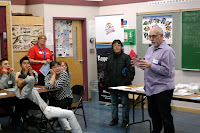Inuujaq School's Safe School Committee organized an Anti-Bullying Week from September 21 - 25. The committee distributed a list of activities they prepared to teachers that focused on how to identify, stop, and prevent bullying in & outside of school. Teachers were encouraged to complete the activities that applied to their respective classes.
Some
of the activities included: Pink t-shirt Anti-Bullying Pledge, Elder & RCMP
Visits to classrooms, and the "Caught you Caring" Campaign. The school's main hallway became filled with
coloured pink t-shirt posters with statements, such as, "I will take turns
sharing toys," "I will stand nicely in line," and "I will
tell a teacher is I see bullying happening." Elders spoke to all students about the negative
effects of bullying and how to stop & prevent it.
The "Caught You Caring" Campaign saw teachers handing out
"I Caught You Caring" cards to students who behaved in a thoughtful
& caring manner towards teachers & peers.
The
main event was the Safe School Artistic Challenge. Classes could prepare an anti-bullying short
film, song, poster(s), or skit and present it at the assembly on the 25th. The winning classes would receive $80.
My
high school classes watched the 2011 documentary Bully. The last time I
played the movie was two years ago. The
film was controversial upon its release due to its shocking content. We were all shocked by the types of bullying
that were recorded on camera. The film
generated classroom discussions on what kind of bullying happens in the
community.
Bullying
is a problem in Arctic Bay, like anywhere else in the world, and it occurs in
& around the school. Cyber bullying
is a particular concern, especially with social networking sites like Facebook. We talked about how to confront bullish
behaviour using non-violent means, such as talking to a teacher, parent, elder,
principal, and/or the RCMP.
I
also displayed an "Incident Reports by Province" pie chart from the Stop A Bully website. Stop A
Bully is "a registered national charity and Canada-wide anti-bullying
program developed in 2009, [that] allows any student to safely report
[incidences of bullying] to school officials." Unfortunately, the pie chart did not provide
statistics from the three territories.
This absence of information prompted many students to guess how many
bullying incidences are reported in the north.
What was also emphasized to students was that there are many bullying
situations that go unreported.
My
students were surprised to learn that I had six bullies in high school: 3 in
Grade 9, 2 in Grade 10, and 1 in Grade 11.
I didn't go into details as to how I survived those three years in high
school. All I added was that I didn't
use physical force of any kind.
 |
| Greg & Geela |
 |
| Safe School Committee. |
The
best was saved for last: the Artistic Challenge. Everyone was eager & excited to see what
each class came up with.
 |
| Kindergarten |
 |
| Grade 3 |
 |
| Grade 4 |
 |
| Grade 5 |
 |
| John talking about what his Grade 7 & 8 students did for the artistic challenge. |
 |
| High school video |
 |
| Anti-bullying posters |
Update:
Greg's Grade 6 class was featured in a CBC North article on October 2, 2015. The article contains a link to the video on
YouTube. Greg's students are enjoying
their time as local celebrities.










































